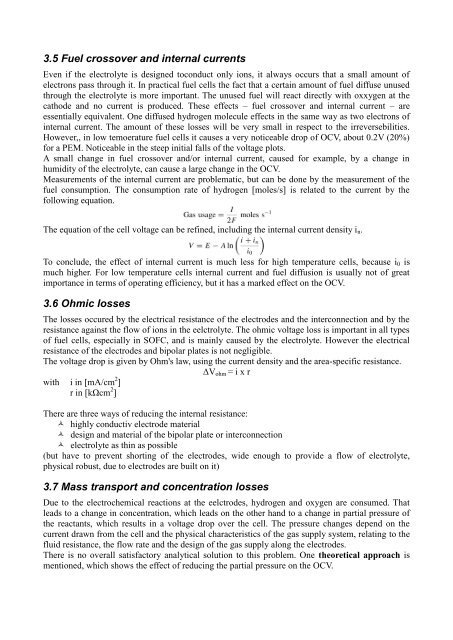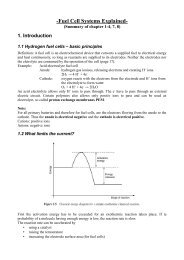Fuel Cell Systems Explained - from and for SET students
Fuel Cell Systems Explained - from and for SET students
Fuel Cell Systems Explained - from and for SET students
Create successful ePaper yourself
Turn your PDF publications into a flip-book with our unique Google optimized e-Paper software.
3.5 <strong>Fuel</strong> crossover <strong>and</strong> internal currentsEven if the electrolyte is designed toconduct only ions, it always occurs that a small amount ofelectrons pass through it. In practical fuel cells the fact that a certain amount of fuel diffuse unusedthrough the electrolyte is more important. The unused fuel will react directly with oxxygen at thecathode <strong>and</strong> no current is produced. These effects – fuel crossover <strong>and</strong> internal current – areessentially equivalent. One diffused hydrogen molecule effects in the same way as two electrons ofinternal current. The amount of these losses will be very small in respect to the irreversebilities.However,, in low temoerature fuel cells it causes a very noticeable drop of OCV, about 0.2V (20%)<strong>for</strong> a PEM. Noticeable in the steep initial falls of the voltage plots.A small change in fuel crossover <strong>and</strong>/or internal current, caused <strong>for</strong> example, by a change inhumidity of the electrolyte, can cause a large change in the OCV.Measurements of the internal current are problematic, but can be done by the measurement of thefuel consumption. The consumption rate of hydrogen [moles/s] is related to the current by thefollowing equation.The equation of the cell voltage can be refined, including the internal current density i n .To conclude, the effect of internal current is much less <strong>for</strong> high temperature cells, because i 0 ismuch higher. For low temperature cells internal current <strong>and</strong> fuel diffusion is usually not of greatimportance in terms of operating efficiency, but it has a marked effect on the OCV.3.6 Ohmic lossesThe losses occured by the electrical resistance of the electrodes <strong>and</strong> the interconnection <strong>and</strong> by theresistance against the flow of ions in the eelctrolyte. The ohmic voltage loss is important in all typesof fuel cells, especially in SOFC, <strong>and</strong> is mainly caused by the electrolyte. However the electricalresistance of the electrodes <strong>and</strong> bipolar plates is not negligible.The voltage drop is given by Ohm's law, using the current density <strong>and</strong> the area-specific resistance.ΔV ohm = i x rwith i in [mA/cm 2 ]r in [kΩcm 2 ]There are three ways of reducing the internal resistance: highly conductiv electrode material design <strong>and</strong> material of the bipolar plate or interconnection electrolyte as thin as possible(but have to prevent shorting of the electrodes, wide enough to provide a flow of electrolyte,physical robust, due to electrodes are built on it)3.7 Mass transport <strong>and</strong> concentration lossesDue to the electrochemical reactions at the eelctrodes, hydrogen <strong>and</strong> oxygen are consumed. Thatleads to a change in concentration, which leads on the other h<strong>and</strong> to a change in partial pressure ofthe reactants, which results in a voltage drop over the cell. The pressure changes depend on thecurrent drawn <strong>from</strong> the cell <strong>and</strong> the physical characteristics of the gas supply system, relating to thefluid resistance, the flow rate <strong>and</strong> the design of the gas supply along the electrodes.There is no overall satisfactory analytical solution to this problem. One theoretical approach ismentioned, which shows the effect of reducing the partial pressure on the OCV.






